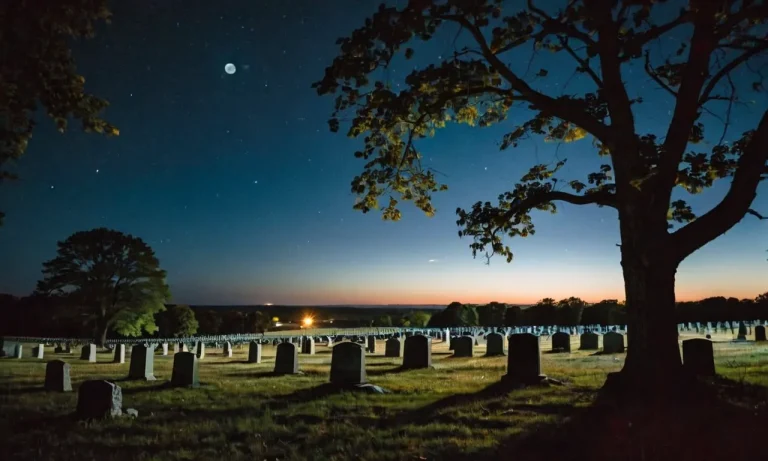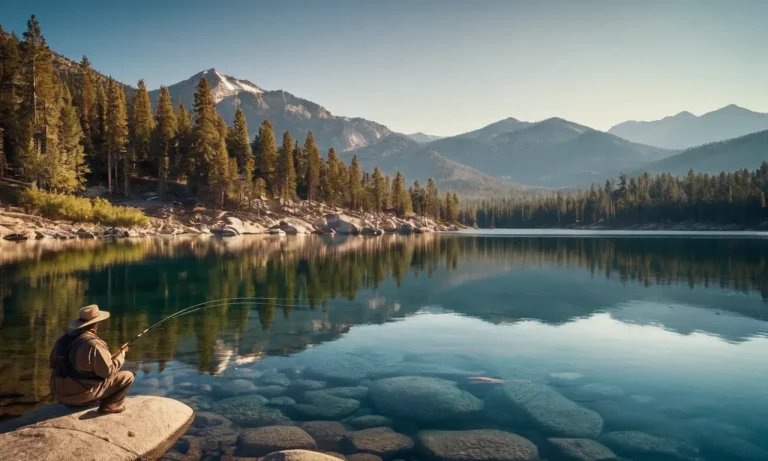The Grim Truth Behind The Dead Bodies In Lake Tahoe
The crystal clear waters of Lake Tahoe conceal a murky secret below the surface. Numerous dead bodies are said to lie preserved in the icy depths due to the lake’s extreme cold temperatures and unique chemistry. But how did they get there? And how many could there really be?
If you’re short on time, here’s a quick answer: While the exact number is unknown, it’s estimated dozens of dead bodies may be submerged in Lake Tahoe. Most entered the water by accident or suicide.
The Phenomenon of Corpse Preservation
Lake Tahoe’s Freakishly Cold Waters
If you’ve ever heard of Lake Tahoe, you probably know it for its stunning beauty and crystal-clear waters. But this picturesque lake has a dark secret – it is home to a number of preserved bodies that have been remarkably well-preserved for years, even decades.
One of the key factors contributing to this phenomenon is the frigid temperature of the lake’s waters.
With an average temperature of around 39 degrees Fahrenheit (4 degrees Celsius), Lake Tahoe’s waters are significantly colder than other lakes in the region. The combination of low temperatures and high elevation creates a unique environment that slows down the decomposition process.
Unlike warmer bodies of water, where bacteria thrive and rapidly break down organic matter, the cold waters of Lake Tahoe act as a natural preservative. The lack of oxygen and nutrients in the water further inhibits decomposition, allowing bodies to remain relatively intact for extended periods of time.
Minimal Decomposition
Due to the exceptional preservation conditions in Lake Tahoe, corpses found in the lake often exhibit minimal decomposition. This has led to several notable cases where bodies have been recovered years after their initial disappearance, appearing almost as if they were recently deceased.
One such case involved the discovery of a man who had gone missing in the 1970s. His body was found over 40 years later, remarkably well-preserved. This extraordinary preservation has been attributed to the cold temperatures and lack of oxygen in the lake’s depths.
The limited exposure to sunlight at the lake’s depths also plays a role in corpse preservation. Sunlight can accelerate decomposition by promoting the growth of bacteria and algae. In Lake Tahoe, the lack of sunlight penetration slows down this process, preserving bodies in a state that is often unrecognizably preserved.
Grim Legends & Myths
The phenomenon of corpse preservation in Lake Tahoe has given rise to a number of grim legends and myths. Some locals believe that the lake is cursed and that the preserved bodies are a result of supernatural forces at play.
One popular legend tells the story of a vengeful spirit that haunts the lake, dragging unsuspecting swimmers down to their watery graves. While these tales may be entertaining, the reality is that the preservation of bodies in Lake Tahoe is a natural occurrence, driven by the unique environmental conditions of the lake.
It’s important to remember that while the preservation of bodies in Lake Tahoe is fascinating, it is also a solemn reminder of the tragedies that have occurred in and around the lake. Each preserved body represents a life lost and a story that will never be fully told.
History of Accidental Drownings
Lake Tahoe, with its stunning beauty and crystal-clear waters, has long been a popular destination for tourists and locals alike. However, beneath its serene surface lies a haunting history of accidental drownings that may surprise many.
Over the years, numerous individuals have tragically lost their lives in the depths of this majestic lake.
Dangerous Currents and Obstacles
One of the primary factors contributing to the history of accidental drownings in Lake Tahoe is the presence of dangerous currents and hidden obstacles. The lake’s strong underwater currents can quickly pull swimmers off course and exhaust even the strongest of swimmers.
Additionally, submerged rocks and fallen trees pose a serious hazard to boaters, making it crucial for visitors to exercise caution while enjoying the lake’s recreational activities.
The U.S. Coast Guard has reported several incidents where people have been swept away by the strong currents, resulting in tragic outcomes. These treacherous conditions serve as a reminder that even seemingly calm waters can be deceivingly dangerous.
Boating and Swimming Mishaps Over the Years
Over the years, there have been numerous boating and swimming mishaps in Lake Tahoe, leading to accidental drownings. Inexperienced boaters and swimmers, coupled with unpredictable weather conditions, have contributed to these unfortunate incidents.
According to statistics from the Lake Tahoe News, there have been several cases where individuals have fallen overboard while boating or have ventured out too far while swimming, unable to make it back to shore.
These incidents highlight the importance of proper water safety education and the need for individuals to be aware of their limitations when engaging in water activities.
Bodies Lost and Never Recovered
Perhaps one of the most chilling aspects of the history of accidental drownings in Lake Tahoe is the number of bodies that have been lost and never recovered. The lake’s cold temperature and deep depths make it challenging for search and rescue teams to locate and retrieve these unfortunate victims.
It is estimated that there are still several bodies resting at the bottom of Lake Tahoe. The uncertainty surrounding their exact locations serves as a haunting reminder of the dangers that lurk beneath the tranquil surface of this beloved lake.
While efforts have been made to improve water safety and prevent future accidents, it is crucial for visitors to respect the power of Lake Tahoe and to exercise caution when enjoying its waters. Understanding the history of accidental drownings can serve as a sobering reminder of the need for vigilance and preparedness when partaking in water activities.
Suicides in Lake Tahoe
Lake Tahoe, known for its serene beauty and crystal-clear waters, holds a grim truth beneath its picturesque surface. It has sadly become a tragically popular spot for suicides. The stunning natural landscape that draws tourists from all over the world also attracts those seeking an end to their pain.
The allure of the deep, tranquil waters has led to a disturbing number of suicides in the area.
A Tragically Popular Spot for Suicides
It is heart-wrenching to acknowledge that Lake Tahoe has become a magnet for individuals contemplating suicide. The reasons behind this disturbing trend are complex and multifaceted. The isolation and solitude provided by the vast expanse of the lake, coupled with its serene beauty, can be both comforting and haunting for those struggling with mental health issues.
The close proximity to urban areas also makes it easily accessible for individuals in distress.
While it is difficult to pinpoint the exact number of suicides in Lake Tahoe, statistics from local authorities and support organizations paint a somber picture. According to the Centers for Disease Control and Prevention (CDC), suicide rates have been steadily rising across the United States, and Lake Tahoe is not exempt from this devastating trend.
Efforts are being made to raise awareness about mental health and provide support for those in need.
Difficulty Recovering Bodies from the Lake’s Depths
Recovering bodies from the depths of Lake Tahoe is a challenging task. The lake’s depth, which reaches up to 1,645 feet, poses significant obstacles for search and rescue teams. The cold temperatures and low visibility further complicate recovery efforts.
It can take days, and sometimes even weeks, to locate and retrieve a body from the lake.
Local authorities, dive teams, and search and rescue organizations work tirelessly to bring closure to the families of those lost to suicide in Lake Tahoe. Their commitment and dedication cannot be understated as they navigate the treacherous conditions to recover the bodies and bring some solace to grieving loved ones.
Continuing Stigma and Awareness Efforts
Suicide remains a highly stigmatized topic, making it even more challenging to address and prevent. Efforts to raise awareness about mental health and suicide prevention are crucial in combating this heartbreaking issue.
Organizations such as the National Alliance on Mental Illness (NAMI) and the American Foundation for Suicide Prevention (AFSP) are actively working to destigmatize mental health and provide resources for those in need.
It is important for communities surrounding Lake Tahoe to come together and support initiatives aimed at mental health awareness and prevention. By breaking the silence and encouraging open conversations about mental health, we can create an environment of compassion and understanding.
Together, we can strive to prevent further tragedies and offer hope to those who feel lost.
Scientific Explanations
Water Temperature and Chemistry
One of the key factors contributing to the presence of dead bodies in Lake Tahoe is its water temperature and chemistry. Lake Tahoe is known for its cold water, with average temperatures ranging from 40 to 65 degrees Fahrenheit.
This cold temperature can slow down the decomposition process, preserving the bodies for longer periods of time. Additionally, the lake’s alkaline nature, with a pH of around 8.2, can further delay decomposition.
These factors create an environment that can preserve bodies for years, making it difficult for them to resurface or be discovered.
Minimal Light and Oxygen
The deep and dark waters of Lake Tahoe also play a significant role in the preservation of dead bodies. The lake is known for its clarity, with visibility reaching up to 70 feet. However, as one descends further into the depths, light becomes scarce.
This lack of light limits the growth of algae and other organisms that would normally consume decomposing bodies. Furthermore, the low oxygen levels at greater depths inhibit the activity of bacteria that aid in decomposition.
These conditions create an environment where corpses can remain relatively intact for extended periods of time.
Precedents in Other Lakes and Water Bodies
The phenomenon of bodies remaining preserved in bodies of water is not exclusive to Lake Tahoe. There have been similar cases reported in other lakes and water bodies around the world. For example, the cold waters of Lake Superior in North America and Lake Baikal in Russia have also been known to preserve bodies for long periods of time.
This suggests that the unique combination of temperature, water chemistry, and limited light and oxygen in these lakes create an environment conducive to the preservation of remains.
It is important to note that while these scientific explanations help us understand why dead bodies can remain in Lake Tahoe for extended periods, they do not make light of the tragic circumstances surrounding these incidents.
The presence of these bodies serves as a reminder of the risks associated with water activities and the need for safety precautions.
Ongoing Efforts to Find and Recover Bodies
As the grim truth behind the dead bodies in Lake Tahoe continues to unfold, authorities and dedicated teams are working tirelessly to find and recover these bodies. The challenging task requires a combination of advanced technology, specialized skills, and unwavering determination.
Sonar Searches and Scuba Dives
One of the primary methods employed in the ongoing efforts to locate the bodies is the use of sonar technology. Sonar, also known as sound navigation and ranging, uses sound waves to map the lakebed and identify potential underwater objects.
This technology has proven to be invaluable in detecting submerged bodies and guiding search and rescue teams to the precise locations.
In addition to sonar searches, scuba divers play a crucial role in the recovery process. These highly trained individuals brave the depths of Lake Tahoe to locate and retrieve the bodies. Equipped with specialized diving gear and guided by sonar data, these divers meticulously search the underwater terrain, often facing challenging conditions and limited visibility.
Their dedication and expertise have led to numerous successful recoveries.
Coping with Grim Discoveries
Discovering a body in Lake Tahoe is a somber and emotionally challenging experience for the search and rescue teams involved. Coping with these grim discoveries requires a unique blend of professionalism and empathy.
These brave individuals undergo extensive psychological training to help them process the emotional toll of their work and provide support to grieving families.
It is important to recognize the immense strength and resilience of these teams as they continue to confront the harsh realities of their mission. Their commitment to bringing closure to families and providing answers in these tragic cases is truly commendable.
Providing Closure to Families
One of the primary goals of the ongoing efforts to find and recover bodies in Lake Tahoe is to provide closure to families who have lost loved ones. The discovery and identification of a body can bring a sense of relief and allow families to begin the grieving process.
Authorities work closely with families, keeping them informed of the progress and any developments in the search and recovery operations. They provide support and guidance throughout the process, ensuring that families have the necessary resources and information they need during this difficult time.
While the truth behind the dead bodies in Lake Tahoe is undeniably grim, the ongoing efforts to find and recover them are crucial in providing closure and healing for the families affected. The dedication and perseverance of the search and rescue teams involved demonstrate the importance of their mission in bringing solace to those who have suffered unimaginable loss.
Conclusion
While the full extent may never be known, it’s clear Lake Tahoe contains a sobering number of accident and suicide victims preserved beneath its picturesque façade. By understanding the scientific and social factors behind this phenomenon, we can grapple with its tragic realities while working to prevent more loss of life in the future.








